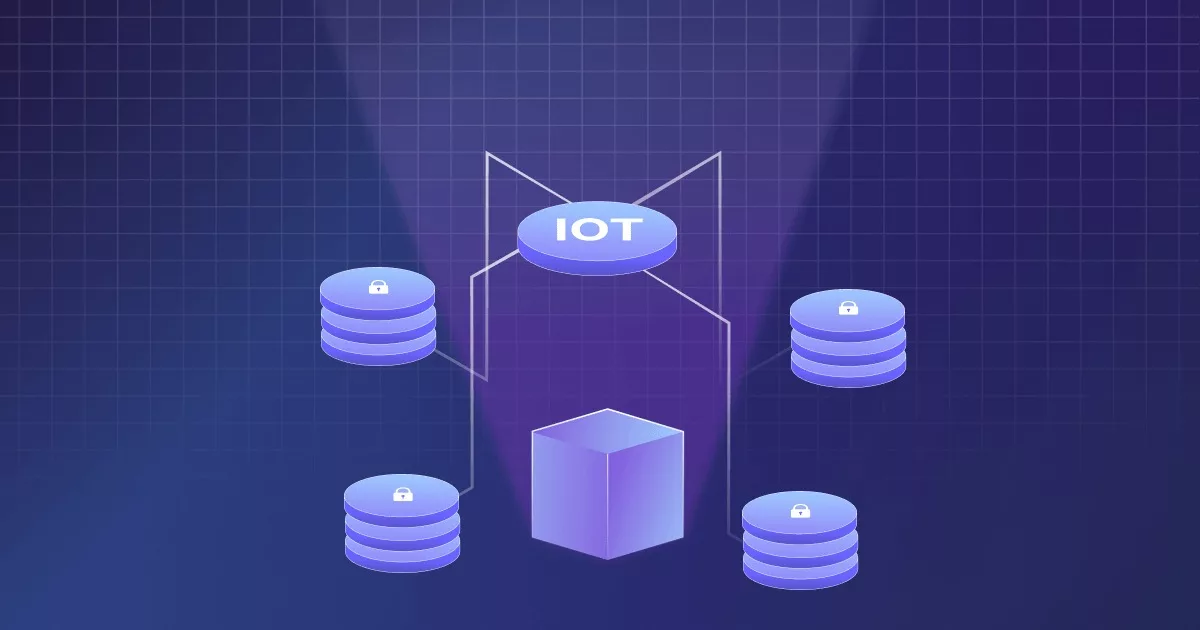
From smart cities to autonomous vehicles and wearables, IoT has connected billions of devices to the internet, generating unprecedented amounts of data.
But, with the increasing reliance on IoT, security and privacy concerns have emerged.
Enter blockchain, the decentralized ledger technology that can secure and manage IoT data.
The convergence of IoT and blockchain has opened up a world of new possibilities for businesses across industries. In this era of data-driven everything, IoT blockchains are poised to play a vital role in shaping our digital future.
In this context, understanding the potential of IoT blockchain use cases is critical for organizations seeking to stay innovative in a rapidly changing technological landscape.
What Is an IoT Blockchain?
An IoT blockchain is the intersection of the Internet of Things (IoT) and blockchain technology.
At its core, blockchain is a decentralized and immutable ledger that records transactions. This makes it an ideal solution for IoT, as blockchain provides a secure and transparent way to track and manage data between IoT devices.
In an IoT blockchain network, IoT devices and sensors can act as nodes on the blockchain network. They can share data and process transactions in a peer-to-peer manner. Moreover, multiple nodes cryptographically sign and verify each transaction. Thus, it would be hard for a malicious actor to manipulate or falsify data.
IoT blockchain applications are emerging in various fields. It ranges from supply chain to energy management, healthcare, finance, and smart cities.
For example, let’s take supply chain management as an example. In this case, IoT sensors can track the location and condition of goods as they move through the supply chain and record it on a blockchain ledger. So this provides a transparent and secure way to track the provenance and authenticity of goods. Moreover, it ensures the products have not been tampered with or counterfeited.
Another example is energy management. IoT devices such as smart meters can be used to monitor energy usage and production and record this data on a blockchain ledger. This also enables transparent and efficient energy management, reducing waste and lowering costs.
Top 7 IoT Blockchain Use Cases
1. Smart cities
Smart cities are a prime example of how IoT and blockchain can work together to improve our daily lives.
They rely on a vast network of interconnected devices to manage everything from traffic flow to waste management. But this setup also creates a vast amount of data that needs to be handled securely and efficiently. That’s where IoT blockchains come in.
For example,
- They enable secure and transparent data sharing between city departments and stakeholders. This can lead to effectively managing city resources, such as energy, water, and waste.
- Also, blockchain can enable new business models that allow citizens to monetize their data. They can do it while still maintaining control over their privacy. Citizens could exchange their energy consumption data with energy companies for lower rates while retaining control over their data.
2. Supply chain management
Supply chain management is another area where IoT blockchains can play a transformative role.
A supply chain is a complex system that involves multiple parties, including manufacturers, suppliers, distributors, and retailers. Each of these has its own set of data and systems. This complexity can make it challenging to track goods and ensure their authenticity.
Using IoT sensors, it is possible to track products in real-time as they move through the supply chain. This data can then be recorded on a blockchain, tracing the product’s journey from production to delivery.
Also, blockchain can enable smart contracts that automatically execute when certain conditions are met. For example, a smart contract could release payment to a supplier once the product has been delivered to the right location.
3. Agriculture
Here are some examples of how IoT blockchains can be used in agriculture.
1.1 Traceability
IoT blockchains can enable end-to-end traceability of agricultural products from farm to table. By recording every step of the supply chain, it is possible to ensure that food products are safe and comply with regulations.
1.2 Certification
IoT blockchains can certify organic, fair trade, or other sustainable farming practices.
1.3 Crop monitoring and management
By integrating IoT sensors into farms, it is possible to collect data on crop health, soil moisture, and other variables. You can use this data to optimize crop management, such as irrigation, fertilization, and pest control.
4. Energy management
Renewable energy certificates and microgrid management are two potential areas to implement IoT blockchain in.
1.1 Renewable energy certificates (REC)
RECs are tradable certificates that represent the environmental benefits of renewable energy production. IoT blockchains can record and create a transparent and secure registry of RECs, which can be traded on a decentralized marketplace. By enabling greater transparency in the REC market, it is possible to incentivize greater adoption of renewable energy sources.
1.2 Microgrid management
A microgrid is a localized energy system operating independently of the larger grid. IoT blockchains can optimize microgrid management by balancing supply and demand or managing storage.
5. Healthcare
IoT blockchain can be a game-changer in healthcare. Below are some critical use cases of IoT blockchain technology in healthcare.
1.1 Electronic health records (EHRs)
The patient records can be collected and securely stored in the decentralized ledger providing access to only authorized personnel.
1.2 Medical device tracking
This helps to trace the product journey preventing counterfeit goods from entering the market.
6. Logistics
Some major benefits of IoT blockchain in Logistics are traceability and transparency.
Besides that, IoT blockchains can improve customs and trade compliance. It leads to efficient data exchange between importers, exporters, and customs officials.
This can reduce delays and errors and ensure all parties comply with regulations and standards.
7. Autonomous vehicles
Integrating IoT sensors into autonomous vehicles makes it easy to collect data on vehicle performance, traffic conditions, and other factors. This data can then be recorded on a blockchain to enable real-time performance monitoring, allowing for early detection and correction of issues that could lead to accidents.
Also, smart contracts can automate various aspects of autonomous vehicle operations. It includes vehicle maintenance, route planning, and insurance claims.
Benefits of IoT Blockchain
1. Security
One of the most significant benefits of IoT blockchains is its security.
Blockchain uses cryptography to secure transactions and prevent tampering or unauthorized access. IoT devices can share data and process transactions securely without relying on a central intermediary.
Also, as blockchain is decentralized, it’s more resilient to attacks and less vulnerable to single points of failure.
2. Transparency
In a blockchain ledger, one can track and trace the history of data and transactions between IoT devices.
3. Decentralization
Blockchain, especially the public type, is known for its decentralized nature. It means there is no single point of control or authority in the network. This makes it more democratic and reduces the risk of abuse by a single entity.
4. Cost-effectiveness
Blockchain technology eliminates the need for intermediaries, reducing costs and increasing efficiency.
Challenges of IoT Blockchain Adoption
1. Scalability
Blockchains can sometimes be slow and resource-intensive. Thus it can be difficult to scale up and handle large volumes of data and transactions from IoT devices. This can result in performance issues and high transaction fees.
2. Energy consumption
Blockchain requires a lot of computing power to verify transactions, which can be energy-intensive. This is particularly true for networks using the Proof of Work (PoW) consensus mechanism.
3. Regulation
Regulatory challenges can also hinder IoT blockchain adoption.
Blockchain technology is still relatively new. Hence, there is a lack of regulatory frameworks and standards governing its use. This can create uncertainty and hinder investment and adoption.
Future of IoT Blockchain
The future of IoT blockchain looks promising, with many potential applications and use cases on the horizon.
Below are some key trends that are shaping the future of IoT Blockchain.
1. Integration with other technologies
One of the key trends in the future of IoT blockchain is integrating with other emerging tech like Artificial Intelligence (AI).
This convergence of technologies will enable the development of innovative solutions.
2. Increased adoption
As the benefits of IoT blockchain become more widely recognized, we expect to see increased adoption of the technology in various industries.
This will be driven by the need for increased security, transparency, and efficiency in data and transaction management and the potential cost savings and revenue opportunities that IoT blockchain can provide.
3. Standardization
As the IoT blockchain ecosystem matures, we can expect increased standardization and interoperability between blockchain protocols. This will help to develop more and more use cases.
4. Regulation and governance
The future of IoT blockchains will be shaped by the development of regulatory frameworks and governance models that enable the safe and effective use of the technology.
Conclusion
IoT blockchain technology aims to transform various industries by enabling new applications that enhance efficiency, security, and transparency.
From agriculture and healthcare to logistics and energy management, the potential benefits of IoT blockchain are vast and varied. By leveraging the power of IoT sensors and blockchain, businesses and governments can optimize processes, reduce costs, and improve sustainability.
FAQs
1. What is IoT blockchain technology?
IoT blockchain is the intersection of the Internet of Things (IoT) and blockchain technology.
At its core, blockchain is a decentralized and immutable ledger that records transactions. This makes it an ideal solution for IoT, as blockchains provide a secure and transparent way to track and manage data between IoT devices.
2. What are the benefits of using blockchain in IoT?
There are several benefits of using blockchain in IoT devices, as mentioned below.
- Security through cryptography
- Transparency by recording transactions on an immutable ledger
- Decentralization which prevents any single point of failure
- Cost-effectiveness and efficiency by reducing intermediaries
3. What are the challenges of implementing blockchain in IoT?
Blockchain can be slow and resource-intensive. Thus, handling vast amounts of data from IoT devices can be difficult. Also, with multiple blockchain protocols, compatibility is quite challenging. Lastly, the lack of regulatory frameworks for blockchain technology further complicates its adoption.
4. How can IoT blockchain be used in the logistics industry?
Some major benefits of IoT blockchain in logistics are traceability and transparency.
Besides that, IoT blockchains can improve customs and trade compliance. It can help in efficient data exchange between importers, exporters, and customs officials. This can reduce delays and errors and ensure all parties comply with regulations and standards.





